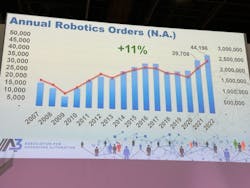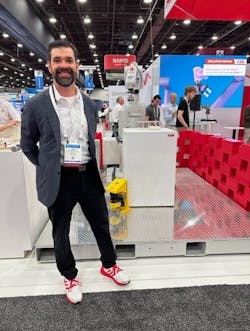Automate 2023: A Robotics & Automation Event Organized Around Market Trends
If 2022 was the record year to beat, Automate 2023 has given robotics event organizers an even greater run for their money!
This year’s event was the biggest yet, featuring 300,000 square feet of exhibit space, 750 exhibitors and 25,000 attendees, according to Jeff Burnstein, president of event organizer A3 (Association for Advancing Automation). The largest robotics and automation trade group in the world, A3 boasts 1,200 member companies.
“[Automate] has been growing by 45% to 50%, to the point where we’re screening for exhibit space this year, and Automate is now going to be an annual show,” Burnstein announced at the event held at Huntington Place in Detroit.
Enthusiasm for market growth was similarly reflected in an industry trends presentation. Alex Shikany, VP, Membership & Business Intelligence, A3, reported that 2022 was a record year in robotics orders, jumping more than 44,000 units for the first time since collecting statistics in the early 1980s.
READ MORE: Gearing up at Automate 2023: Schaeffler Showcases Latest Components for Robotics
A3 research, he reminded the audience, is segmented between automotive, which includes OEM and components orders, and non-automotive, which includes life sciences, electronics, metals, plastics and everything that is not bundled under the automotive segment.
“The industry came back from a more historic norm in terms of automotive orders,” he said. “The automotive segment really took an upswing [in 2022], and you’re going to walk around [the show] and see a lot of automotive applications. One of the things driving this is the route to electrify the supply chain…The move has driven the need for robotics.”
Compared to 2022, the start of 2023 revealed a more tempered outlook. North American companies ordered fewer robots in the first quarter of 2023 than for the same period last year. According to A3, companies ordered 9,168 units valued at $597 million in Q1 2023, a 21% drop in total units and a 10% drop in value over the same quarter in 2022.
A3 also stated that automotive customers accounted for 68% of all robot orders in Q1 of 2023, with 5,659 robots purchased. During Q1, non-automotive orders in consumer goods, semiconductor & electronics, plastics & rubber, life sciences/pharmaceutical/biomedical, metals and others purchased 3,519 robots, were down 42% over Q1 2022.
Burnstein stated in a press release that inflation and a slowing U.S. economy may have taken a slight toll on robot orders overall, but that the automotive sector continues to fast-track purchase orders as they make the transition to manufacturing electric vehicles.
“Non-automotive companies are typically newer to automation and may be waiting to invest more until they’ve tested recent deployments or see the economy begin to recover,” he said.
READ MORE: 5 for Friday: Automate is on the Rise—and on the Move in an Expanding Market
Add to this the fact that labor shortages continue to be a key risk in the growth of automation. That’s all the more reason manufacturers look for ways to handle the “dull, dirty and dangerous” tasks that can be handled by robots, Shikany said.
“I don’t think automation is about taking away jobs anymore,” said ABB’s U.S. Robotics Division president, John Bubnikovish. “What we saw recently, is the Congressional Budget Office had released that 0.2% annual increase in labor from 2024 to 2031. And, when you look at that, there’s essentially 2.1 million jobs left unfilled. So, it’s not about taking jobs anymore. It’s about how can you have some continuity in your business to continue to operate at the production levels that you have.
“[Moreover], how do you expand? And that’s where I think the real value from automation comes from nowadays; it’s not going to replace workers necessarily. It is that we can’t find workers to do these jobs anymore, so we’re going to have to automate.”
That demand was evident in investments made in AI, motion and vision control, as well as communications and networking solutions that bring together hardware and connected devices into a software environment.
For her part, Barbara Humpton, CEO and president, Siemens Corporation, made the case for using augmented intelligence, or the use of qualitative data sets, to enable the programming of PLCs. “This makes every one of us capable of programming the automation,” she said during her keynote. This is no longer out of reach to the people we are going to need to bring it into the workforce. This is the power of the platform.”
READ MORE: Automate 2023 Welcomes Economical, Flexible Automation Solutions
Siemens is developing a software-enabled controller that is designed to be hardware agnostic. “We know that manufacturing environments everywhere are heterogeneous,” Humpton said. “Over the decades we’ve brought technology from all kinds of suppliers into this working world and we had these solutions working side by side.
“And now the virtual PLC enables us to access that hardware through a software interface. Why would we want to do this? Well, for a couple of reasons. One, we do want to start thinking about hardware as a service.”
She explained further that the Siemens Xcelerator open digital transformation platform can enable service technicians to get alerts on their iPhones if equipment needs attention. Technicians would be able to see the diagnostics as they stream through the application interface and then be able to take corrective action. “Think about what this might do for our workforce management,” she said.
Humpton’s keynote presentation offered an overarching upbeat philosophical message about optimizing for change. “What we’ve been talking about here is the introduction of technologies. But if you listen closely, what we’re really talking about is who we are as people, and how we operate in this world of incredible opportunity.
"And the question I’ve been asking myself, and I hope you’ll join me in this quest, is to answer this question: Instead of trying to find an optimal state of being, what would it look like if we got our teams to focus on optimizing for being in a state of constant change?”
Attendees to Humpton’s keynote would have found plenty to mull over on the trade show floor. “There’s so much demand for automation, and Automate, we believe, is the leading event for people to learn how to successfully apply these technologies,” Burnstein said.
The next Automate will be held from May 6-9, 2024 at McCormick Place, Chicago.
Excellence in Robotics
Jeff Burnstein, president of the Association for Advancing Automation (A3), knows a thing or two about robotics. He was selected as one of two recipients of the prestigious Joseph F. Engelberger Robotics Award, which recognizes excellence in technology development, application, education and leadership. As this year’s the Leadership award recipient, Burnstein was recognized for his four decades of commitment and vision at the global automation trade association.
“Winning the Engelberger Robotics Award for Leadership is beyond any accomplishment I could have imagined when I started at the association 40 years ago,” said Burnstein. “The award has been described as the ‘Nobel Prize of Robotics’ for good reason, as it is acknowledged globally as our industry’s pinnacle of success. As an English major with no technical background at all, I am living proof that there is a home for anyone in the robotics industry.”
The other recipient was Roberta Nelson Shea, global technical compliance officer, Universal Robots. Nelson Shea received the award in the Application category for her outstanding work in the development of industrial robot safety standards in North America and around the world.
About the Author

Rehana Begg
Editor-in-Chief, Machine Design
As Machine Design’s content lead, Rehana Begg is tasked with elevating the voice of the design and multi-disciplinary engineer in the face of digital transformation and engineering innovation. Begg has more than 24 years of editorial experience and has spent the past decade in the trenches of industrial manufacturing, focusing on new technologies, manufacturing innovation and business. Her B2B career has taken her from corporate boardrooms to plant floors and underground mining stopes, covering everything from automation & IIoT, robotics, mechanical design and additive manufacturing to plant operations, maintenance, reliability and continuous improvement. Begg holds an MBA, a Master of Journalism degree, and a BA (Hons.) in Political Science. She is committed to lifelong learning and feeds her passion for innovation in publishing, transparent science and clear communication by attending relevant conferences and seminars/workshops.
Follow Rehana Begg via the following social media handles:
X: @rehanabegg
LinkedIn: @rehanabegg and @MachineDesign



